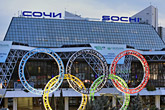First double-decker passenger train for Sochi arrives
A double-decker, long-distance passenger train on the Moscow–Sochi route arrived at the southern city of Rostov-on-Don. This was a demonstration run of the train, which, starting on Nov. 1, will begin regular operations between the Russian capital and the host city of the 2014 Winter Olympics.
The new double-decker carriages, manufactured in Tver, are producing mixed reactions: The passenger train bears a slight resemblance to an armored train of the World War II era.
It may be because of the standard-size windows, which look like small and narrow firing slits when installed on a huge carriage. It could also be due to the fact that the grey color of the train, against the background of leaden clouds, asphalt and the stone walls of the station, look like military camouflage.
Nevertheless, on the inside of the carriage, passenger will find a world of modern civilization—three bio-toilets, Wi-Fi, air conditioning, etc. There is also a device for lifting wheelchairs, and the dining car has two elevators for getting food and tableware to the second floor.
Ladders—or rather, narrow staircases—connecting the first and second floors are equipped with convex mirrors, so that passengers do not run into one another.
“These carriages will take almost double the number of passengers, in comparison with the regular rolling stock,” said Vladimir Pyastolov, first deputy chief of North Caucasus Railways. “Thanks to this, we will reduce the price of tickets by about 22 percent, in comparison with regular trains operating on this route.”
Railway officials also point out that seats on the second floor will be somewhat more expensive than seats on the first floor, but they could not provide any specific figures.
In response to a question about the preparations of domestic transportation infrastructure to meet double-decker cars (which are both wider and much heavier than regular carriages), Pyastolov said: “In advance of the Winter Olympic 2014, all tunnels have been widened, and foundations of railway embankments were fortified, so the new carriages can operate without any restrictions.”
Fist published in Russian in Rossiyskaya Gazeta.
All rights reserved by Rossiyskaya Gazeta.
Subscribe
to our newsletter!
Get the week's best stories straight to your inbox

